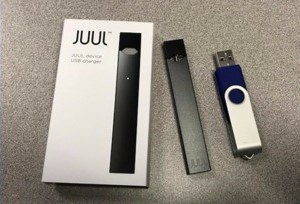Nurse
Page Navigation
- Larkin High
- Nurse's Office
- Vaping and Marijuana
Vaping and Marijuana
-
Vaping
Electronic cigarettes, commonly referred to as “vapes”, were introduced to the American market between 2006 and 2007. The most popular product, JUUL, is responsible for about 72 percent of the vaping market. Since then, the practice has become increasingly popular, especially among teenagers, due to the affordability and variety of flavors. In addition to nicotine, marijuana can be vaped as well.
Vaping is believed to be a safer alternative to cigarettes, but it comes with risk factors. According to the Centers for Disease Control and Prevention, there have been nearly 3,000 reports to the CDC of vaping-related hospitalizations in the United States as of February 2020 - and 64 deaths. Vaping, like smoking, is strictly prohibited on school property at all times, including during the school day and all after-school activities. Students are prohibited from possession or using any type of a drug at school (prescription or over the counter drugs require notification to the school nurse). This also includes employees, parents, guardians or visitors on school property.
Vaping, like smoking, is strictly prohibited on school property at all times, including during the school day and all after-school activities. Students are prohibited from possession or using any type of a drug at school (prescription or over the counter drugs require notification to the school nurse). This also includes employees, parents, guardians or visitors on school property. Vape Compared to USB Vape devices are easy to hide from teachers and parents, because of their size and lack of odor. Certain vapes have a similar appearance to pens or USB drives.
Susanne Tanski, a pediatrician and former chair of the tobacco consortium at the American Academy of Pediatrics, said she and colleagues are observing first-time Juul users becoming addicted within two months, compared to two years or more for a smoker to become dependent on cigarettes.
Key parts of the brain continue to develop into the mid 20s, according to the CDC. Consistently using a vape leads to functional impact on teen brain development.

-
Marijuana
It is important for parents to recognize how much marijuana has changed since the 1960s. In addition to smoking parts of the cannabis plant, today’s products include marijuana mixed into foods (edibles), cannabis wax, vaporizers, and more.
The potency of marijuana has also been increasing for years. The average potency today is about six to seven times stronger than it was in the mid 90s. Higher potency leads to a variety of effects, including:
- Difficulty thinking and making decisions
- Distorted perceptions
- Impaired balance and coordination
- Paranoia
- Problems with learning and memory
- Acute psychosis, including delusions and panic
Teens who regularly use marijuana have been shown to exhibit:
- Poor academic performance
- Higher school drop-out rates
- Higher unemployment rates
- Lower satisfaction with life
- Higher rates of welfare enrollment
-
Communication with your Child
It is recommended for parents to have regular, but not forced, conversation with their children about the topics of vaping and marijuana. Listen more than you talk, teens are more likely to make good decisions and feel more understood if their parents listen. Consider the ratio of 75 percent listening and 25 percent talking. Be sure to validate your child first rather than lecturing or trying to solve the problem right away.
Don’t forget to help your child build internal tools, including self-confidence, authenticity, social skills, and resilience.

